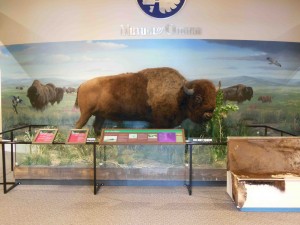affiliates in the news- November 2014
Congrats to these Affiliates making news! Each month we highlight Affiliate-Smithsonian and Affiliate-Affiliate collaborations making headlines. If you have a clipping highlighting a collaboration with the Smithsonian or with a fellow Affiliate you’d like to have considered for the Affiliate blog, please contact Elizabeth Bugbee.
Poverty Point State Historic Site (West Carroll, Louisiana)
Poverty Point to celebrate World Heritage Site designation Saturday
According to the Office of the Lieutenant Governor, Poverty Point is the 22nd World Heritage Site in the United States. Dardenne’s office states that Poverty Point was the U.S. Department of the Interior’s lone nomination for world heritage status-adding to the site’s accolades as a National Historic Landmark, National Monument and Smithsonian Affiliate.

George Catlin, Buffalo Chase, Bulls Making Battle with Men and Horses. 1832-1833, oil on canvas, Smithsonian American Art Museum, Gift of Mrs. Joseph Harrison, Jr.
Mennello Museum of Art (Orlando, Florida)
Mennello Museum opens final exhibits in 15th-anniversary season
The Mennello Museum of American Art is wrapping up its 15th-anniversary year with two exhibitions that opened Oct. 3. The two new exhibitions are “George Catlin’s American Buffalo,” on loan from the Smithsonian American Art Museum, and “The Taos Society of Artists,” an original exhibition curated by museum executive director Frank Holt. The exhibitions run through Jan. 4, 2015.
The Majesty of the Buffalo, Captured on Canvas [16 Images]
In Great Falls, the exhibit was received enthusiastically, and the museum saw an uptick in attendance. “We’re delighted to have this quality of an exhibition from the Smithsonian,” Burt said, adding that the scenes provided Native Americans with “a great opportunity” for insight into their ancestors’ lifeways and the scenery of the plains.
 Space Center Houston (Houston, Texas)
Space Center Houston (Houston, Texas)
Space Center Houston is 1st Smithsonian Affiliate in Houston
Space Center Houston is now a member of the Smithsonian’s crew. Space Center Houston, which serves as the official visitor center for NASA’s Johnson Space Center in Texas, is officially the first museum in Houston to be named a Smithsonian Affiliate.
Another giant leap for Space Center Houston
In a giant leap toward preserving the history of space exploration, Space Center Houston became the city’s first Smithsonian Affiliate on Oct. 8
Witte Museum (San Antonio, Texas)
Witte Museum announces Smithsonian partnership
We purposely waited to become a Smithsonian Affiliate because we’re in a great transformation right now at the museum and we thought it would be the perfect way to say we’re a top-tier museum,” said Marise McDermott, Witte Museum president and CEO.
Witte now a Smithsonian affiliate
The Witte Museum is now a Smithsonian Institution Affiliate. As a member of the program, the Witte will be able to borrow objects from the Smithsonian’s permanent collection and tap into its resources. “It’s such a great time for the Witte to have an affiliation,” said Marise McDermott, president and CEO of the Witte, who will announce the affiliation at a news conference this morning. “Before we were so focused on growing our campus, and now we’re ready to integrate with a national museum.”

Berkshire Museum (Pittsfield, Massachusetts)
Smithsonian Leaders Hail Berkshire Museum SparkLab Partnership
“We think that real innovation will happen in this space,” according to Claudine Brown, Assistant Secretary of Education & Access at the Smithsonian. “Every SparkLab is different, and this one is architecturally beautiful.”
Spark!Lab is hands-on science at Berkshire Museum
Berkshire Museum Executive Director Van Shields said, while tinkering on his own Snap Circuits project, that Spark!Lab will “stimulate the kind of creativity and innovative thinking that was the beginning of the journey” of bringing the museum into the 21st century.
 The Biomuseo (Panama)
The Biomuseo (Panama)
Biomuseo Showcases Panama’s Ecological Diversity
Panama, the Biomuseo proclaims, became a “bridge of life” (the title of its permanent exhibition) and a fountain of biodiversity. Just a bit bigger than Ireland, it has more species of birds, amphibians and animals (if insects are included) than the United States and Canada combined, according to George R. Angehr, a research associate at the Smithsonian Tropical Research Institute in Panama. (The Biomuseo is an affiliate of the Smithsonian, which along with the University of Panama helped develop its scientific content.)
Wondrous or hideous? Frank Gehry-designed natural history museum opens to fanfare in Panama
A natural history museum designed by famed architect Frank Gehry opened in Panama City this week. The Biomuseo – a project first conceived nearly 15 years ago and hampered by all kinds of issues – welcomed in the public for the first time Thursday.
Idaho Museum of Natural History (Pocatello, Idaho)
Asian Pacific American History exhibit on display at IMNH
Asian and Pacific Americans make up more than five percent of the U.S. population–more than 17 million people–and those numbers are growing. Their ancestral roots represent more than 50 percent of the world, extending from East Asia to Southeast Asia, and from South Asia to the Pacific Islands and Polynesia. In commemoration of this important history, “I Want the Wide American Earth: An Asian Pacific American Story” opened at the Idaho Museum of Natural History (IMNH), on September 20 and will run through November 30. “I Want the Wide American Earth” was created by the Smithsonian Asian Pacific American Center and the Smithsonian Institution Traveling Exhibition Service (SITES). The exhibition is supported by a grant from the W.K. Kellogg Foundation.
Smithsonian exhibit heads to local museum
“It’s pretty exciting because we are a Smithsonian-affiliated museum…and we only get it for ten weeks so it’s here before it heads-off to California, so unless you are planning on traveling to California, you won’t get to see it,” Tews said.









